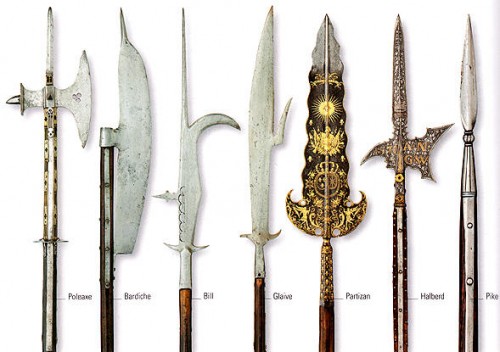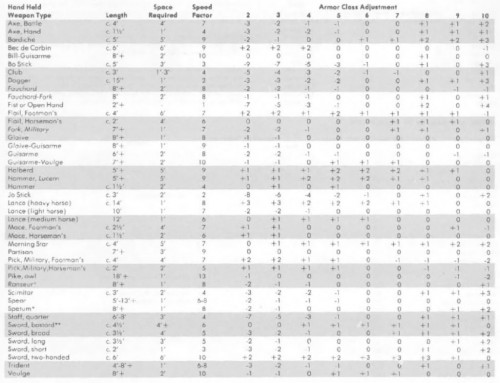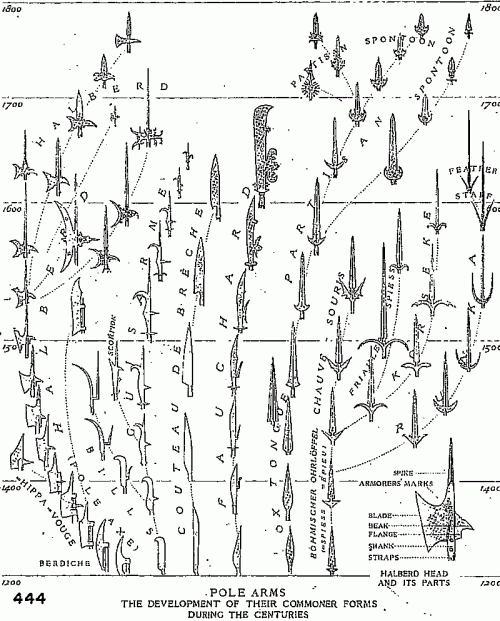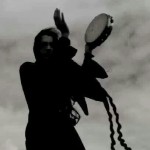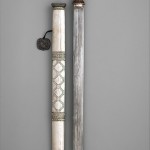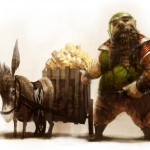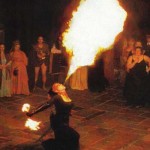In which we create a simple polearm specialist for use in Fifth Edition Dungeons & Dragons.
Remember when Dungeons & Dragons loves polearms? My old orange-spined Player’s Handbook couldn’t get enough of them. To this day I crack a whimsical smile when I see a fauchard for sale at the Home Depot. Why? Because Fauchards and Glaives and Billhooks were the stuff of adventure, dammit.
A polearm is a beautiful thing. Attach something to the end of a long hand. Hit fools with it. What do you attach to it? Oh anything, really. Lots of polearms look like they started out life as farm or orchard tools re-purposed for slaughter. Those that showed promise eventually developed into refined, elegant, knightly implements of slaughter.
One problem that came up with some frequency was that of specialization. If an adventuring warrior were to specialize in the use of, say, the Bec de Corbin, he has put himself in a bit of a corner. With such a dizzying assortment of polearms available, what are the odds that a given villain, henchling, or long-buried hero of old would have a matching magical weapon? Warriors benefit tremendously from having enchanted armaments, and picking the wrong specialization is troublesome. Type V Dungeons & Dragons addresses this by doing away with specialization in the first place. Instead there are optional feats that lend themselves towards various broad categories of weapons and fighting styles. Whether you use shortbows or longbows or crossbows or thrown darts you can benefit from Sharpshooter. Similarly there is a Polearm Master feat that applies to most long-stick-intensive weapons.
Four feats are of particular interest:
- Great Weapon Master – This grants a bonus action to attack upon landing a critical hit or felling an opponent, plus the option to take a penalty to hit in exchange for more damage. Polearms are typically heavy weapons wielded in two hands, so this would apply to a polearm-swining lug just fine.
- Polearm Master – This grants a bonus action to attack with the butt-end of your polearm and grants a reaction attack when opponents enter within reach. Clearly this feat is best-used by characters that do not have a lot of other opportunities to trigger a bonus action or reaction.
- Shield Master – Has a few benefits for Dexterity-based saving throws and allows a bonus action to shove an opponent. You can wield a Quarterstaff one-handed, so technically you can benefit from both this and Polearm Master at the same time. Why this combination doesn’t apply to spears is beyond me, as the spear-and-shield combination is literally a classic. Bronze-age classic.
- Sentinel – Reduces the movement of anybody hit by an opportunity attack to zero for the turn, denies opponents the ability to Disengage safely, and allows a reaction attack against opponents that attack one’s allies. This is 5e’s melee lock-down mechanism, presumably present for the benefit of people who enjoy computer games and Type IV D&D.
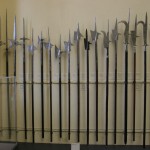 The use of feats poses certain challenges, though. Most classes gain a feat at 4th, 8th, and 12th level, at the cost of foregoing an attribute score improvement. To select a feat is to pay an opportunity cost, and to pay dearly at that. One could invest three feats in Polearm Mastery, Great Weapon Mastery, and Sentinel, and thus become a heavy-hitting melee specialist locking down a 25′ swath of the battlefield. This combination sounds lovely, but your Dwarven Paladin isn’t going to have all the pieces in place until 12th level, at which point frankly your campaign is probably already over. It seems to me that, generally speaking, more than one feat is hard to justify for a typical campaign. Unless we get our feats for pennies on the dollar, that is! And boy, do I have a deal for you!
The use of feats poses certain challenges, though. Most classes gain a feat at 4th, 8th, and 12th level, at the cost of foregoing an attribute score improvement. To select a feat is to pay an opportunity cost, and to pay dearly at that. One could invest three feats in Polearm Mastery, Great Weapon Mastery, and Sentinel, and thus become a heavy-hitting melee specialist locking down a 25′ swath of the battlefield. This combination sounds lovely, but your Dwarven Paladin isn’t going to have all the pieces in place until 12th level, at which point frankly your campaign is probably already over. It seems to me that, generally speaking, more than one feat is hard to justify for a typical campaign. Unless we get our feats for pennies on the dollar, that is! And boy, do I have a deal for you!
Start out by looking at the call-out on page 31 of the Player’s Handbook, the Variant Human option. Instead of taking +1 on all of your attributes, take +1 to each of two attributes of your choice and pick up a feat at 1st level. Lovely, we can start our adventuring career with part of our gimmick already in-hand. Now we can get our third feat at 8th level instead of 12th. But that means we won’t get to bump up any of our attributes, like the all-important Strength or Constitution, until 12th level. Assuming we’ll be retired or dead right around then, that’s still a bit of a delayed gratification.
Behold, another solution presents itself. Tucked away on page 70 is an under-rated character class called the “Fighter.” The Fighter, you must understand, is a newfangled specialist class introduced in 1974 that is supposed to be rugged and skilled in the use of arms. In 5th Edition Dungeons & Dragons they have the distinction of gaining attribute improvements (and additional feats) at levels 4, 6, 8, 12, 14, and 16. This means we can have three feats at level six. That’s half the level as our baseline, leaving opportunities to maybe pick up a couple of bonuses before being put out to pasture.
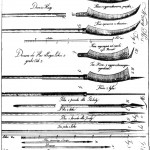 We’ve picked a race (Human) and a class (Fighter), so it’s time to divvy up some starting attributes. I’m a fan of the standard array, as point buy leads to min/max abuses and cancer of the soul. All of our polearm trickery won’t be of much use if we aren’t hitting our targets, and none of our thematic weapons have the “finesse” quality, so our primary concern is Strength. Dexterity need not be of any great concern, as we can get by using heavy armor. Constitution is tremendously important for anybody whose primary role in combat is getting stuck in with the hostiles, so we’ll make it our secondary concern. Intelligence is lovely for anybody in the real world, but if you were really smart you’d get yourself a good steady job that doesn’t involve getting stabbed. Low priority. We could say the same about Wisdom, but some of the more concerning magic effects in the game use Wisdom for a saving throw, and skills like Insight, Medicine, and Perception all key off of this attribute. Tertiary priority. Charisma is of similar priority as Intelligence. Both are nice to have but non-essential to this gimmick. We assign 15 to Strength, 14 to Constitution, 13 to Wisdom, 12 to Charisma, 10 to Dexterity, and 8 to Intelligence. We apply our Human bonuses and end up with a statline of Str 16 Dex 10 Con 14 Int 8 Wis 14 Cha 12.
We’ve picked a race (Human) and a class (Fighter), so it’s time to divvy up some starting attributes. I’m a fan of the standard array, as point buy leads to min/max abuses and cancer of the soul. All of our polearm trickery won’t be of much use if we aren’t hitting our targets, and none of our thematic weapons have the “finesse” quality, so our primary concern is Strength. Dexterity need not be of any great concern, as we can get by using heavy armor. Constitution is tremendously important for anybody whose primary role in combat is getting stuck in with the hostiles, so we’ll make it our secondary concern. Intelligence is lovely for anybody in the real world, but if you were really smart you’d get yourself a good steady job that doesn’t involve getting stabbed. Low priority. We could say the same about Wisdom, but some of the more concerning magic effects in the game use Wisdom for a saving throw, and skills like Insight, Medicine, and Perception all key off of this attribute. Tertiary priority. Charisma is of similar priority as Intelligence. Both are nice to have but non-essential to this gimmick. We assign 15 to Strength, 14 to Constitution, 13 to Wisdom, 12 to Charisma, 10 to Dexterity, and 8 to Intelligence. We apply our Human bonuses and end up with a statline of Str 16 Dex 10 Con 14 Int 8 Wis 14 Cha 12.
As a Fighter we’re entitled to a fighting style at level 1. Archer, Duelist, and Two-weapon don’t really apply well here. Duelist would if we were to use a Quarterstaff, but I want to go with a more traditional polearm aesthetic, so that leaves us with Defense, Great Weapon, and Protection. Protection allows you to use your reaction to impose disadvantage under some circumstances. We’re already looking to use reactions from other sources, so that isn’t so handy. Great Weapon fighting style lets us re-roll 1’s and 2’s on damage dice when using a two-handed weapon. That’s nice, but it’s just a little extra damage. We take Defense for a flat +1 to armor class. With no shield or Dexterity bonus and likely to be stuck in the scrum, we can use all the help we can get in that department.
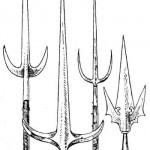 For a background we’ll be boring and pick up Soldier. We roll some dice and see that we spent time as a Standard Bearer in the military, are always polite and respectful, we value “might” as an ideal, feel that those we fight with are worth dying for, and our hatred for our enemies is blind and unreasoning. This also gets us proficiency in Athletics and Intimidation as well as tool proficiency in one type of gaming set (Chutes & Ladders) and vehicles(land). For our Fighter skills we pick up Perception and Insight. Because we’re clearly some kind of social butterfly. For our free Human skill, we pick up Animal Handling. It goes with our land vehicle proficiency and suits our delicate nature.
For a background we’ll be boring and pick up Soldier. We roll some dice and see that we spent time as a Standard Bearer in the military, are always polite and respectful, we value “might” as an ideal, feel that those we fight with are worth dying for, and our hatred for our enemies is blind and unreasoning. This also gets us proficiency in Athletics and Intimidation as well as tool proficiency in one type of gaming set (Chutes & Ladders) and vehicles(land). For our Fighter skills we pick up Perception and Insight. Because we’re clearly some kind of social butterfly. For our free Human skill, we pick up Animal Handling. It goes with our land vehicle proficiency and suits our delicate nature.
At last, we pick up equipment. From the Fighter starter package we get chainmail armor, two Martial weapons (a Glaive and a Warhammer), two handaxes, and an explorer’s pack. From our background we get and insignia of rank, a trophy taken from a fallen enemy, a set of bone dice, a set of common clothes, a belt pouch, and ten gold coins.
At 1st level we look something like this:
| Pole Dancer | ||||||||||||||||||||||||||||
|---|---|---|---|---|---|---|---|---|---|---|---|---|---|---|---|---|---|---|---|---|---|---|---|---|---|---|---|---|
| Human Fighter 1 Soldier Background Lawful Evil
Skills: Animal Handling (+4), Athletics (+5), Insight (+4), Intimidation (+3), Perception (+4) |
From the outset he’s reasonably tough, is capable of laying out two attacks per round in melee for 1d10+3 and 1d4+3. Outside of a fight his athleticism is useful for physical challenges and at least not a liability socially. Let’s roll him forward to 6th level:
At this point we could have taken Polearm Master, Sentinel, and Great Weapon Master feats, but the benefits of Great Weapon Master are a bonus attack under limited cirmstances and a bonus to damage at a heavy attack penalty. Bringing Strength up to 18 makes a lot of sense for getting more value out of it when we eventually pick it up at 8th or 12th level.
The Battle Master archetype is selected because we’ve more or less set ourselves up around being tricky in a fight. Being able to decide to trip an opponent during a reaction, extend from 10′ reach to 15′, or steal an opponent’s attention all fit nicely with a melee Swiss Army Knife approach to the world.
On the road to a typical campaign’s end-game, he’ll get another ability score bump or two, some magical arms and armor, a fifth Superiority Die, and maybe four more maneuvers, see his Superiority Die bump up from d8 to d10, and get a third attack per round with the main end of his weapon. With any luck he’ll have a broad range of implements with which to ply his trade during this time, from his first Glaive to a Halberd or two, maybe the DM will let him have a Ranseur or Bill Hook or Partisan. Who knows?
